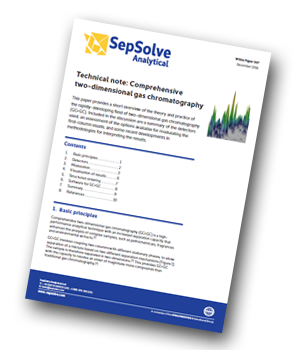SepSolve Analytical has produced a technical note providing a short overview of the theory and practice of the rapidly-developing field of two-dimensional gas chromatography (GC×GC). Included in the discussion are a summary of the detectors used, an assessment of the options available for modulating the first-column eluate, and some recent developments in methodologies for interpreting the results.
 Basic Principles
Basic Principles
Comprehensive two-dimensional gas chromatography (GC×GC) is a high performance analytical technique with an increased separation capacity that enhances the analysis of complex samples, such as petrochemicals, fragrances and environmental extracts. GC×GC involves coupling two columns with different stationary phases, to allow separation of a mixture based on two different separation mechanisms.
Detectors
GC×GC has been coupled with a range of detectors, but due to the narrow peak widths generated in the secondary column, a detector with a data acquisition rate of 30–200 Hz is often used. A popular detector used with GC×GC is flame ionisation detection (FID). FID is an affordable and rugged detector well-suited for quantitative analysis of hydrocarbons, since the response is directly proportional to the number of carbons present in the analyte molecules. However, confident identification can be difficult because retention times (1tR and 2tR) must be used to characterise the components. Instead, coupling to a mass spectrometer provides an additional level of information on the sample composition by allowing identification of specific peaks based on chemical structure.
Software for GC×GC GC×GC data is acquired by a detector in a linear (1D) format, so specialist software is required to ‘fold’ the data (based on the known modulation time) in order to view colour and surface plots. There are now a number of commercially-available software packages for GC×GC data processing – some are specific to a particular instrument, such as ChromaTOF® (LECO) and ChromSquare (Shimadzu), while others are capable of processing third-party data files from a range of instrumentation, such as ChromSpace® (Markes International) and GC Image™ (GC Image LLC).
GC×GC data is acquired by a detector in a linear (1D) format, so specialist software is required to ‘fold’ the data (based on the known modulation time) in order to view colour and surface plots. There are now a number of commercially-available software packages for GC×GC data processing – some are specific to a particular instrument, such as ChromaTOF® (LECO) and ChromSquare (Shimadzu), while others are capable of processing third-party data files from a range of instrumentation, such as ChromSpace® (Markes International) and GC Image™ (GC Image LLC).
SepSolve recommends the use of ChromSpace, due to its robust peak merging, deconvolution and simplified workflows. It is often the case that two dimensions of separation are still not sufficient to fully separate the most complex of samples, so deconvolution can play a large role in this type of analysis.




